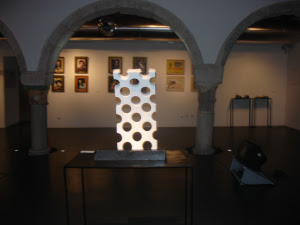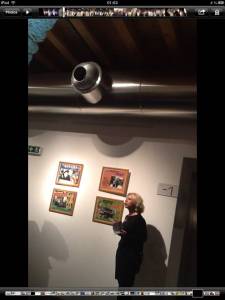| MiMo Museu da Imagem Leiria |
Text BY THE ART CURATOR Genoveva Oliveira
Contemporaneity leads us to a discussion around a perspective of the post-modern body or the post-human body. The body is the last frontier to cross or to decode. The collective exhibition of modern art “Corpo e Corpos, transgressões e narrativas/Body and Bodies, transgressions and narratives” appeals to the definition of a human being whose identity is always under construction and intertwined to a cultural context. Bodies reflect, at times, a plural dissonance, a balanced swinging. Sometimes, they are androgynous bodies, enthusiastic in gestures, inspiring in sexual suggestions, but esthetically beautiful (Alexandre Batista’s work). Sexuality can be approached under an immensity of perspectives, as the restlessness of emotions, actions and meanings in an quest enraptured by desire (Maria João Franco, Filipe Curado and Nelson Dias’s works).
“Body and Bodies, transgressions and narratives” reveals five supports (painting, sculpture, photography, dance and video), five experiences of guest artists and artists whose work embodies the museum collection, that not only reflect a conceptual and formal investigation, but also narrate a new way that opens itself to the exploring of the bodily dimension and its performance (Helena Beatriz/ Escola Annarella e Jochen Dietrich’ works). A construction that is sometimes ambiguous and codified in its appearance by the several social discourses. The relation of the woman figure, sometimes the heroin, others an anonymous character, is analyzed and reflected in the issues about physical and psychological violence, as well as in other gender problems perceivable in the works of Andrea Inocêncio, Isabel Lima and Carla Cruz, where the clearly Portuguese symbolical references are present, as an integral part of the pressing challenges of the contemporary society.
Sometimes, the speech is also an allegorical construction referring to a technological intervention about the human body that stimulates measurement rhetoric of the degree of invasion of privacy, and questions the limits of the private and public sphere, given that space is a web of plans of action where each one executes, in simplicity and with meaning (Paulo Henrique’s work).
A contemporaneidade lega-nos à discussão em torno de uma perspectiva do corpo pós- moderno ou pós-humano. O corpo é a ultima fronteira a atravessar ou a descodificar. A exposição colectiva de arte contemporânea “Corpo e Corpos, transgressões e narrativas/Body and Bodies, transgressions and narratives” apela para a definição de um ser humano onde a identidade está sempre em construção e interligada a um contexto cultural. Os corpos reflectem por vezes uma dissonância plural, um equilíbrio desequilibrante, por vezes, são corpos andróginos, aficionados nos gestos, inspiradores nas sugestões sexuais, mas esteticamente positivos (obra de Alexandre Batista). A sexualidade pode ser abordada sob uma imensidade de perspectivas como o desassossego de sentimentos, acções e significados na procura arrebatada de desejo (obras de Maria João Franco, Filipe Curado e Nelson Dias).
“Corpo e Corpos, transgressões e narrativas” revela cinco suportes (Pintura, escultura, fotografia, dança, vídeo), cinco experiências de artistas convidados e artistas cuja obra incorpora o acervo do museu, que reflectem uma investigação conceptual e formal, mas também narram um novo caminho que se abre à exploração da dimensão corporal e da sua performance (obras de Helena Beatriz/ Escola Annarella e Jochen Dietrich), uma construção, por vezes, ambígua e codificada no seu aspecto pelos diversos discursos sociais. A relação da figura da mulher, por vezes heroína, por vezes personagem anónima ou omitida é analisada e reflectida nas questões sobre a violência física e psicológica, bem como outras problemáticas de género visíveis nas obras das artistas Andrea Inocêncio, Isabel Lima e Carla Cruz, onde as referências simbólicas marcadamente portuguesas estão presentes, como parte integrante dos desafios prementes da sociedade contemporânea.
Por vezes, o discurso é também uma construção alegórica referente a uma intervenção tecnológica sobre o corpo humano onde estimula a retórica de medição do grau da invasão da privacidade e interroga os limites da esfera publica e privada, sendo o espaço uma teia de planos de acção onde cada um executa, em simplicidade e com significado (obra de Paulo Henrique). http://
 |
| Nelson Dias |
 |
| Nelson Dias |
 |
| Maria João Franco |
 |
| Maria João Franco |








































No comments:
Post a Comment